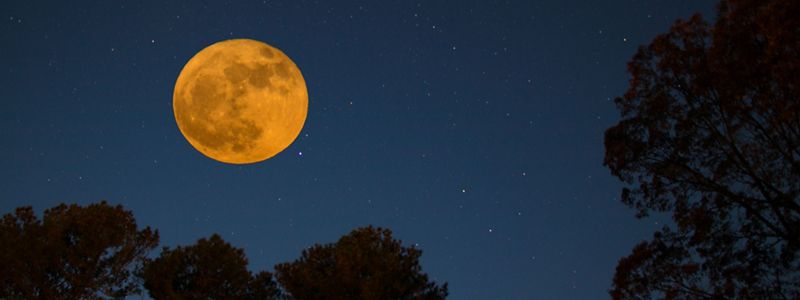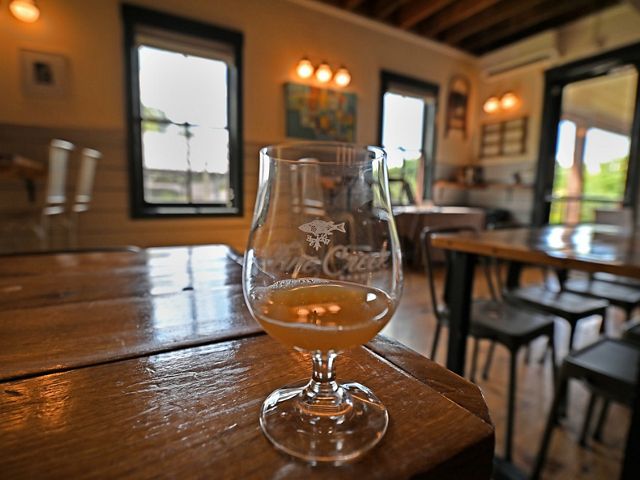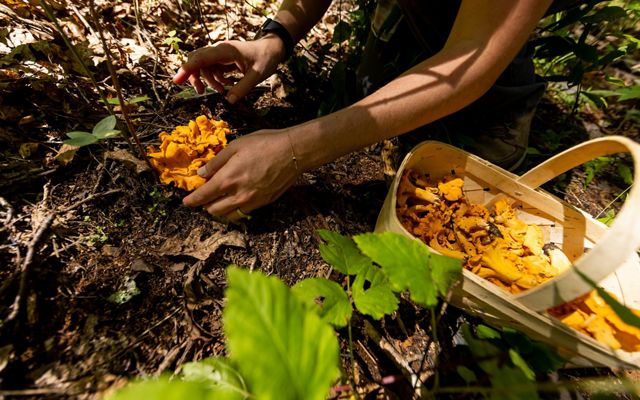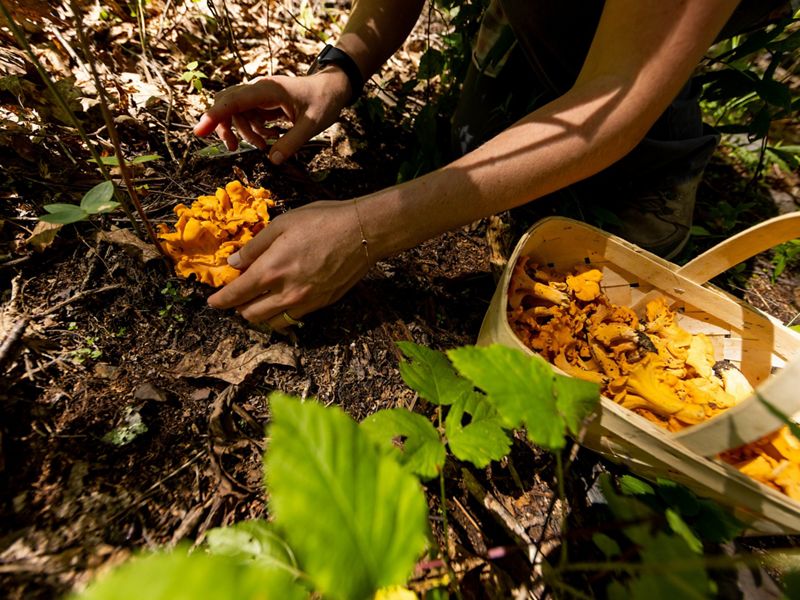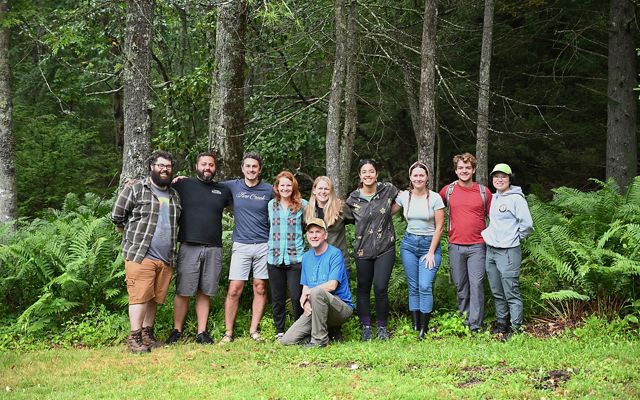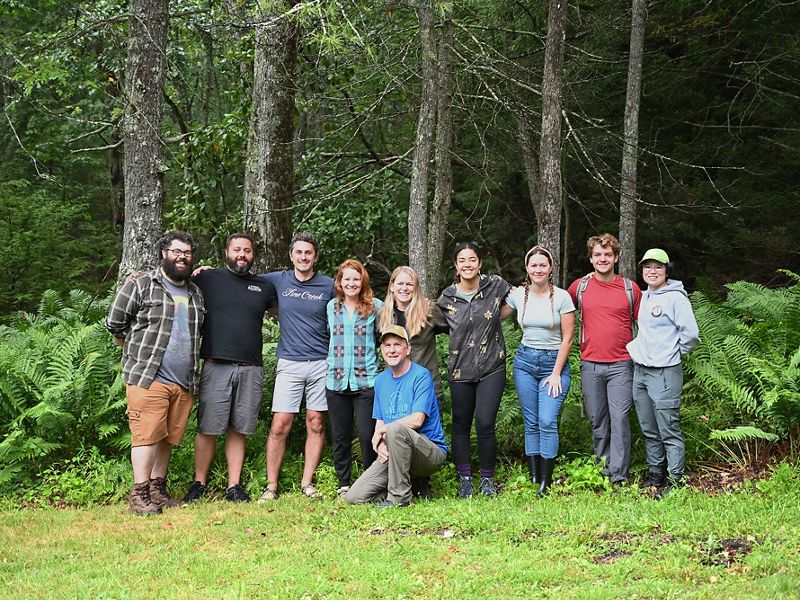OktoberForest: Taste Virginia
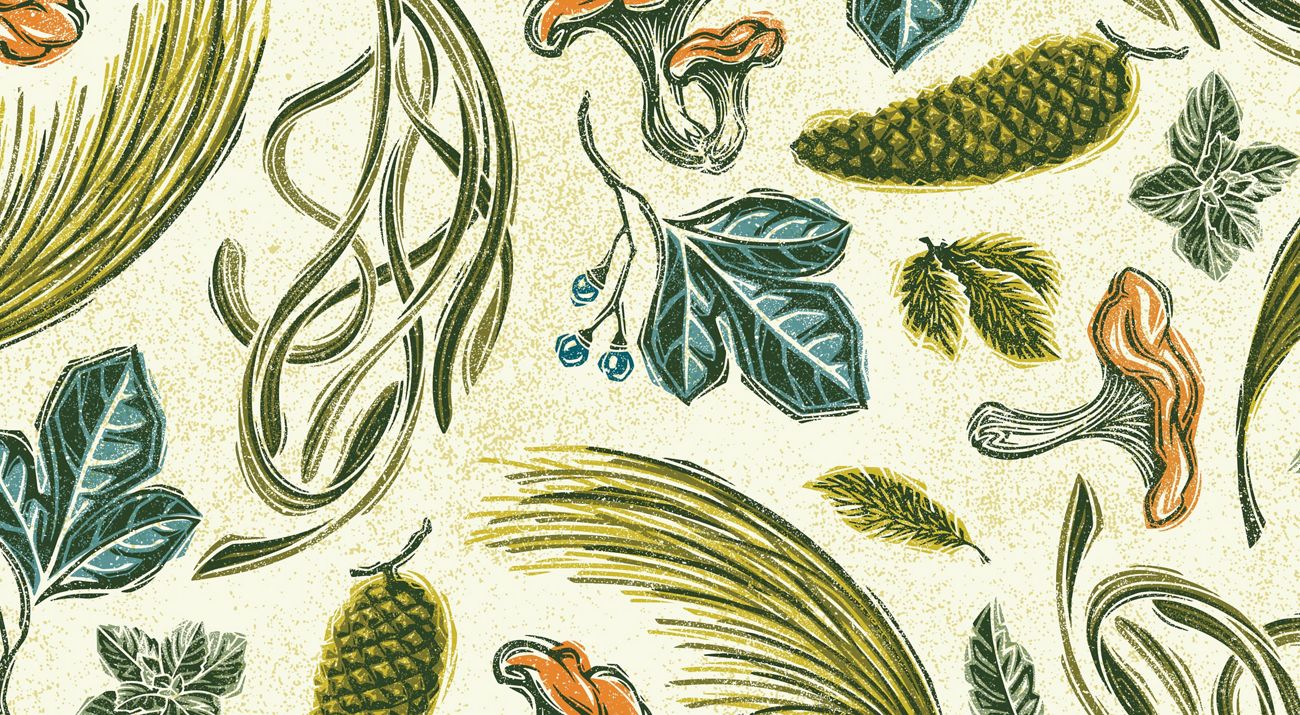
Celebrating the lands and waters on which all life—and beer—depends
By Daniel White, Senior Conservation Writer
Scooping seagrass from the deck of a skiff. Foraging sassafras leaves under the canopy of a mountain forest. Clipping red spruce tips after a hike up a steep ridge. Gathering pine needles, bark and cones from a longleaf savanna. No, these aren’t scenes from Gordon Ramsey: Uncharted. Nor is it how craft brewers typically procure ingredients.
Carefully collected by hand, four wild ingredients offer an expression of Virginia’s lands and waters that you can literally taste.
These adventures kicked off a collaboration to create the OktoberForest Virginia Collection. The brainchild of Virginia brewer Josh Chapman, the venture built upon his original crazy idea (his words) to brew an India pale ale with longleaf pine, which TNC and our partners are restoring in the Virginia Pinelands.
Chapman proposed inviting three additional breweries to expand this collaboration. Our 2025 brewers include Fine Creek Brewing, Sweetbay Brewing, Upweller Beer Company and Väsen Brewing Company each paired with one of TNC’s other landscape-conservation programs to create a new beer that—like Chapman’s Piney Grove IPA—features an iconic local ingredient.
Continue scrolling to meet the brewers and click on the tabs above to learn more about each beer. Go behind the scenes of the careful collection of the wild ingredients that offer an expression of Virginia’s lands and waters that you can literally taste.
Quote: Brian Mandeville
The deeply passionate people doing the work of habitat restoration in these mountain forests were kind enough to share this magnificent space with our team, and we are excited to share an element of that mountain in this beer.
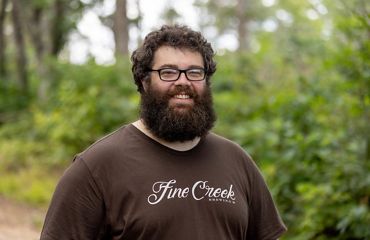
Quote: Josh Chapman
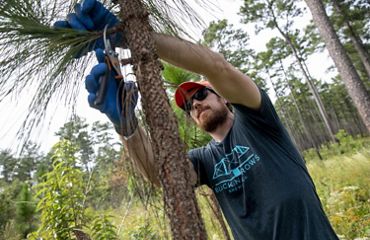
We all gathered needles, branches and cones after an incredible tour of Piney Grove. I was blown away by the passion of the team behind the longleaf restoration.
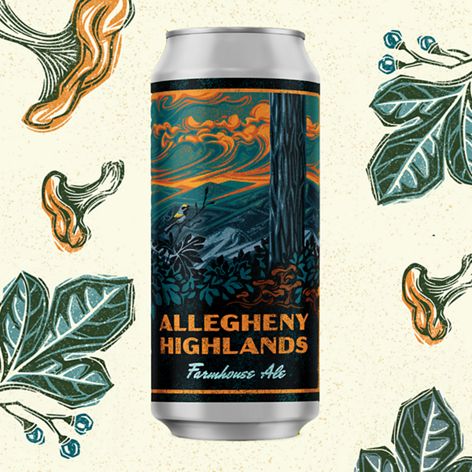
Allegheny Highlands Farmhouse Ale
Sassafras leaves foraged from Warm Springs Mountain Preserve—where fire is bringing diversity back to iconic Appalachian forests—highlight this farmhouse ale.
Fruits of the Forest
The Central Appalachians are known for ecological diversity, so identifying one signature ingredient was the first big challenge in western Virginia's Allegheny Highlands when OktoberForest began in 2022. Blueberries were a first thought. But then the TNC team rallied around Program Coordinator Zoe McGee's more creative suggestion to feature chanterelle mushrooms.
"We were nervous because we felt like it was a little bit of an unconventional ingredient," McGee says. "But the second we pitched the idea to Brian at Fine Creek Brewing, he was so excited."
Still, Mandeville and his Fine Creek team were anxious about finding enough chanterelles. "Mushrooms can be kind of fickle as far as availability goes," he says. "You're not going to find this amount of chanterelles in, like, Richmond."
On Warm Springs Mountain, mushroom abundance is not an issue—but timing can be. In 2023, when rainfall didn’t happen at the right time for mushroom foraging, the team pivoted to sassafras. That beer was such a hit that 2024 will again feature sassafras.
Fruits of the Forest
As our climate changes, the Appalachians are serving as a crucial habitat highway—it has never been more important to invest in healthy, dynamic and diverse forest systems. It’s a message that resonate in the taste of Allegheny Highlands Farmhouse Ale.
Explore the Allegheny Highlands

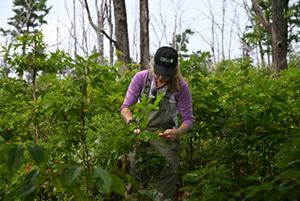
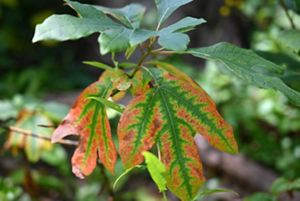
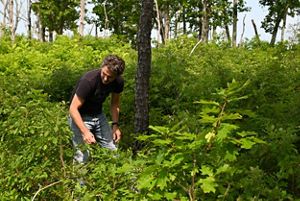
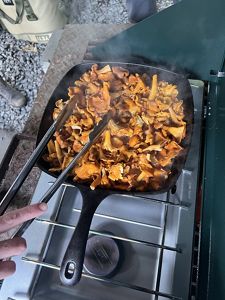
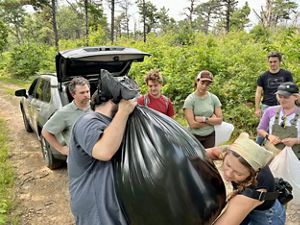
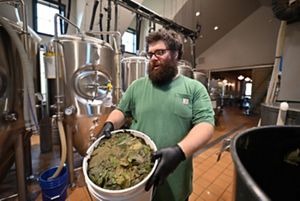
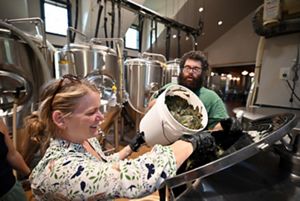
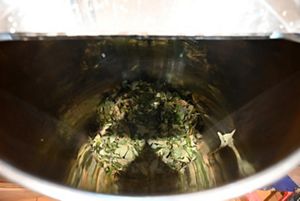

Mountain Gold: For optimal growth—and foraging—chanterelles need moisture, but in 2023, the days leading up to the planned collection date had been dry. © Kyle LaFerriere Photography

A Distinctive Aroma: TNC's Laurel Schablein savors the aroma of a freshly cut chanterelle mushroom, robust and earthy with a subtle fruit character. © Kyle LaFerriere Photography

Forest Foraging: Allegheny Highlands Program Coordinator Zoe McGee forages for sassafras leaves. The brewing team had to quickly pivot to a new ingredient when chanterelles proved scarce. © Daniel White / TNC

Sassafras Leaves: Sassafras is the main ingredient in traditional root beer, and when dried and ground into filé powder, it's a distinctive element in Louisiana Creole cuisine. © Daniel White / TNC

Searching for Sassafras: Fine Creek Brewing founder Mark Benusa forages for sassafras leaves at Warm Springs Mountain Preserve. © Daniel White / TNC

Fruits of the Forest: Cooking freshly foraged chanterelle mushrooms at Trappers Lodge, Warm Springs Mountain Preserve. © Daniel White / TNC

A Bountiful Harvest: The foraging team gathers all of the sassafras leaves foraged on Warm Springs Mountain Preserve. © Daniel White / TNC

Adding a Little Sass: Head Brewer Brian Mandeville prepares to empty a bucket of defrosted sassafrass leaves into a steeping tank at Fine Creek Brewing. © Daniel White / TNC

Adding the Leaves: TNC's Zoe McGee and Head Brewer Brian Mandeville empty a bucket of defrosted sassafras leaves into the steeping tank at Fine Creek Brewing. © Daniel White / TNC

Steeping the Sassafras: Boiled wort is piped into the tank filled with 20 pounds of sassafrass leaves at Fine Creek Brewing. © Daniel White / TNC
Cooking Out at Camp Sassafras
According to Conservation Project Manager Laurel Schablein, an experienced forager, “chanterelles are just dispersed all throughout the forest floor.” For optimal growth—and foraging—you need moisture, but the days leading up to the planned collection date had been dry.
In 2022, two days of foraging yielded 50 pounds of mushrooms. In 2023, bright spots of orange were few to be found. The team needed to pivot—quickly. They settled on sassafras. Numerous Indigenous communities in North America have used the plant's leaves for medicinal purposes. Sassafras is the main ingredient in traditional root beer, and when dried and ground into filé powder, it's a distinctive element in Louisiana Creole cuisine.
While there weren't enough chanterelles for beer, the intrepid foragers returned to historic Trappers Lodge with mushrooms enough to enjoy during a gourmet campfire dinner. “We had a big old pot of mushrooms bubbling away on the campfire and had a really lovely feast,” Schablein says.
Quote: Brian Mandeville
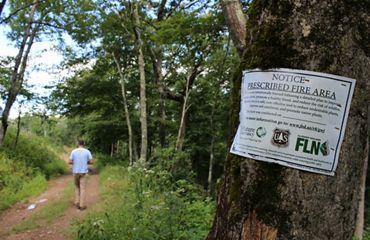
The mountain forest where we gathered sassafras leaves for this project is more open than it once was, thanks to a prescribed burn program that is restoring diverse habitat.
Brian Mandeville
Head Brewer, Fine Creek Brewing Co.Flavors of the Forest
Whether it’s mushrooms sprouting from spores or future mighty oaks bursting from acorns, regeneration is what The Nature Conservancy’s work in this landscape is all about.
“This part of the Central Appalachians is known as a hotspot for biodiversity,” says Blair Smyth, who leads TNC’s Allegheny Highlands team. Decades of fire suppression, however, threaten a stagnation effect. So a major focus here has been reintroducing fire, which creates openings, lets in sunlight and encourages new hardwood seedlings.
As our climate changes, the Appalachians are serving as a crucial habitat highway for plants and animals to migrate. Thus, it has never been more important to invest in healthy, dynamic and diverse forest systems. The TNC team here hopes this message will resonate as people taste Allegheny Highlands Farmhouse Ale, and consider the intricate connections between our food and drink and the natural world that provides them.
“I really see beers being this vehicle to reconnect people with things that maybe we've lost touch with otherwise,” Mandeville says. “That's the history of beer in the first place; it's reflected the land that it came from.”
Explore Our Work
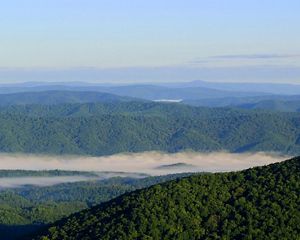
Allegheny Highlands Program
Working to ensure that these mountains at the edge of Appalachia remain a natural stronghold against climate change.
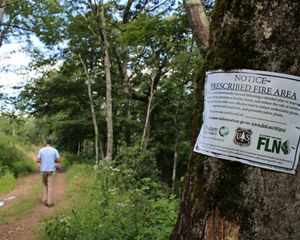
Fire, Management and Monitoring
Learn how the Allegheny Highlands Program uses fire to maintain biological diversity in an ecosystem critical to climate change migration.
lastUpdated lastUpdated
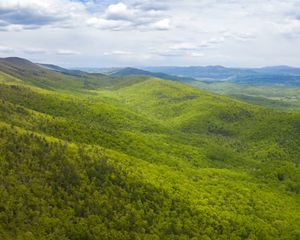
Warm Springs Mountain Preserve
Explore this 10,000 acre preserve in the heart of the Allegheny Highlands.
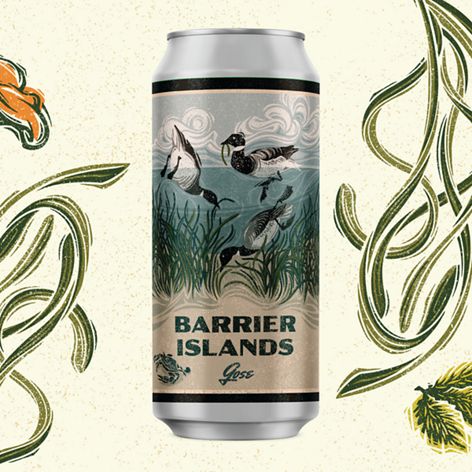
Barrier Islands Gose
Eelgrass collected from underwater meadows in the Virginia Coast Reserve—the site of the largest and most successful seagrass restoration effort on Earth—brings complex coastal flavors to this gose inspired by Virginia's wild barrier islands.
Seagrass Stories
TNC Coastal Scientist Bo Lusk grew up on the Eastern Shore, learning from his grandmother how to fish and catch crabs. Together, they waded with dip nets into eelgrass beds along the Chesapeake Bay’s shallows. And he remembers listening to her stories about eelgrass disappearing from the peninsula’s seaside waters, and with it the disappearance of important habitat and food for a variety of marine life.
“Eelgrass here on the seaside disappeared when she was a teenager,” Lusk explains. The habitat was likely already in serious decline when a major hurricane in the early 1930s ripped out the rest. Or so it seemed.
In a case of right place at the right time, Lusk graduated from the University of Virginia—where he’d been studying seagrasses—in the late 1990s. Around this same time, Bob Orth at the Virginia Institute of Marine Science (VIMS) was working out how to restore the system following the discovery of a tiny patch in South Bay.
The rest is not yet history, but it is historic. For the past 15 years, Lusk has collaborated with VIMS on the largest, most successful seagrass restoration project in the world. “What we've planted [600 acres] has actually spread on its own to nearly 10,000 acres of grass,” he says.
Lusk has taken the torch from his grandmother and become the storyteller, singing the praises of this incredibly rich system to anyone who will listen. “I can geek out on it until people totally stop listening to me,” he says. “To get the Väsen crew out here—they're so interested to learn about this grass, not just what it tastes like, but how we're doing this, why it matters—it's made for some really good conversations.”
Seagrass Stories
Eelgrass (Zostera marina) provides critical nursery habitat for commercially important species like crab and bay scallop, helps take the punch out of storm waves and could play an important role in carbon storage as we confront a changing climate.
Explore the Volgenau Virginia Coast Reserve










A Story of Success: For the past 15 years, The Nature Conservancy has collaborated with VIMS on the largest, most successful seagrass restoration project in the world. © Kyle LaFerriere Photography

Natural Ingredients: "Eelgrass reminds me of some kind of herb, maybe parsley or like a really mild shiso [with] just a bit of sweetness underneath it.” © Kyle LaFerriere Photography

Harvesting Eelgrass: I saw how much cleaner & more available it was than I imagined. There are rafts of this eelgrass sitting on the surface of the water like it was begging for us to pick it up. © Kyle LaFerriere Photography

A Coastal Wilderness: VVCR's 14 undeveloped barrier islands provide critical wildlife habitat and help to protect Eastern Shore communities from storm surges and sea level rise. © Kyle LaFerriere Photography

Gathering Ingredients: “We'll wait until we're done boiling and the wort starts cooling down, then we'll add the eelgrass and let it steep.” © Kyle LaFerriere Photography

Successful Collection: Taking a pause to celebrate a successful day of eelgrass collection. © Kyle LaFerriere Photography

Sea to Table: "I would love for people 200 years from now to be able to experience the environments that we experience today.” © Kyle LaFerriere Photography

Coastal Meadows: In the early 1930s, a noxious slime mold and the powerful Chesapeake-Potomac Hurricane combined to devastate seagrass meadows in Virginia’s coastal bays. © Kyle LaFerriere Photography

Virginia Coast Reserve: Healthy natural communities can make a difference in places like VA's Eastern Shore, vulnerable to rising seas and more frequent and intense storms due to climate change. © Kyle LaFerriere Photography

A Growing Success: Starting from a mere remnant, TNC and VIMS have broadcast more than 72 million seeds to help accelerate the natural spread of eelgrass, now covering more than 9,500 acres. © Kyle LaFerriere Photography
Sippin' on the Top of the Bay
Väsen’s Spenser Jett imagined that the price for entering into this conversation would involve squeezing into snorkeling gear and swimming with scissors. It’s hard to tell whether he’s relieved or disappointed that collecting eelgrass for brewing turned out to be easier than expected.
“I saw how much cleaner and more available it was than I could have imagined,” Jett says. “I mean, there are rafts of this eelgrass sitting on the surface of the water like it’s almost begging for us to pick it up.”
Similar to how Lusk and his grandmother had fished for crabs, he guided the Väsen crew through wielding a dip net to scoop up eelgrass leaves into a pile on the deck of the boat. In short order, the team filled several mesh laundry bags—plenty for the brewing process Jett and his team had in mind.
“We decided on making a gose, a German sour ale,” Jett says. “It's a light-drinking, mineral, crispy, enjoyable beer basically made for hot days.” Pronounced go-suh, the style typically also has a salty flavor, and the team anticipated the eelgrass contributing briny-seaweed notes.
After tasting the grass, however, Jett was pleasantly surprised to discover more complexity than expected: “It reminds me of some kind of herb, maybe parsley or like a really mild shiso [with] just a bit of sweetness underneath it.”
Jett compared the planned brewing process to making tea. “We'll wait until we're done boiling and the wort starts cooling down,” he says. “Then we'll add the eelgrass and let it steep.”
Quote: Spenser Jett
There are rafts of this eelgrass sitting on the surface of the water like it’s almost begging for us to pick it up.
Spenser Jett
Brewer, Väsen Brewing Company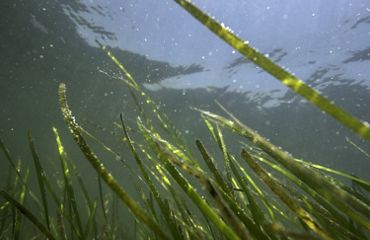
Suds and Sustainability
“I was so excited to hear that Väsen wanted to make something out of eelgrass,” says Lusk. “I'm super pumped to get to work with them.”
Asked if his grandmother would approve, Lusk laughed. “She would hate it,” he says. “A lady like that would never drink beer.”
With the explosion in popularity of craft beer, however, a generational tide has turned. Moreover, goses and other sour beers are riding a wave of popularity. So, both TNC and Väsen are eager to introduce their combined audiences to the flavor of eelgrass and the story of its resurrection in the Eastern Shore’s seaside bays.
“We would love for people to drink these local sustainable beverages, just like we want people to eat local and sustainable food,” Jett says. “I think it helps strengthen people's connection to the things that they consume. And I would love for people 200 years from now to be able to experience the environments that we experience today.”
Explore Our Work
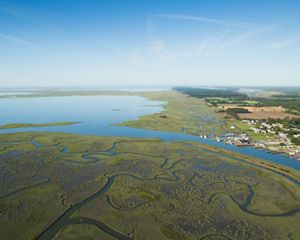
Volgenau Virginia Coast Reserve
Learn more about our work to protect and preserve the longest expanse of coastal wilderness remaining on the east coast.

Restoring Eelgrass on Virginia’s Eastern Shore
Go into the water and behind the scenes at the Volgenau Virginia Coast Reserve for the largest successful seagrass restoration project in the world!
lastUpdated lastUpdated
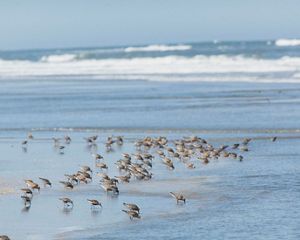
Barrier Islands
VVCR's 14 barrier and marsh islands provide ideal habitat for migratory birds and other wildlife.
Oct 19, 2022
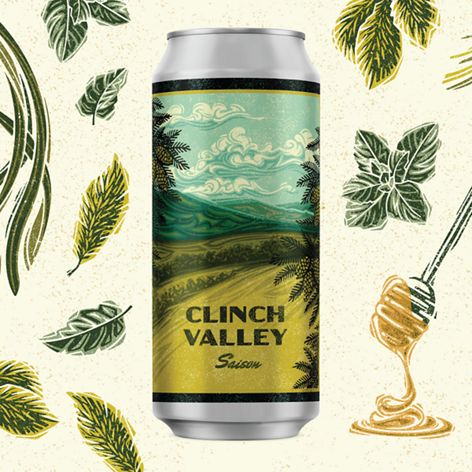
Clinch Valley Amber Lager
Appalachian red spruce tips carefully cut from trees high up on Clinch Mountain—a focal area for restoring the Appalachians' iconic red spruce forest—accent this rich amber lager.
Did You Say Beer or Bear?
“We want to be bear aware,” Tal Jacobs tells the group. “We probably won't see any with how many people we have, but it is Beartown Mountain,” Jacobs adds, with a laugh.
Beartown is one of the peaks that make up the long ridgeline of Clinch Mountain, a dominant landscape feature in far-southwest Virginia. Jacobs, a conservation forester with The Nature Conservancy’s Clinch Valley program, led a recent project here to plant 25,000 red spruce seedlings spanning across a TNC easement and a state wildlife management area.
But for OktoberForest, Jacobs led an expedition. The group traveled to “one of the most difficult places to reach on any lands that we manage,” he says, piloting UTVs to the end of a steep mountain road. The group then continued on foot, the last hour following deer trails to their destination: a red spruce forest perched at an elevation of 4,500 feet.
The journey and the destination proved equally exciting. As Jacobs puts it, “[we were going] to really earn making this beer.”
A Precious Resource
It’s not just red spruce that’s at stake. As our climate changes, scientists say these cool, moist forests are becoming increasingly important habitats for wildlife seeking more hospitable living conditions.
Explore the Clinch Valley










A Day at the Office: Clinch Valley Program Community Outreach Manager Nick Proctor takes the wheel of an UVT to begin the climb to the peak of Beartown Mountain. © Kyle LaFerriere Photography

View From the Top: Clinch Valley team members piloted UTVs to the end of a steep mountain road on Beartown Mountain. © Kyle LaFerriere Photography

In the Driver's Seat: Clinch Valley Conservation Forester Tal Jacobs led the ingredient collecting expedition to “one of the most difficult places to reach on any lands that we manage.” © Kyle LaFerriere Photography

Beartown Mountain: Beartown, one of the peaks that make up the long ridgeline of Clinch Mountain, a dominant landscape feature in far-southwest Virginia. © Kyle LaFerriere Photography

Treking to the Top: Reaching the end of the road, the group continued on foot, following deer trails to their destination: a red spruce forest perched at an elevation of 4,500 feet. © Kyle LaFerriere Photography

Red Spruce: Conservation Forester Tal Jacobs led a recent project in the Clinch to plant 25,000 red spruce seedlings spanning across a TNC easement and state wildlife management area. © Kyle LaFerriere Photography

Collecting Spruce Tips: “Spruce can give you a bunch of different flavor characteristics depending on how you use it. The green new tip is going to be very citrus, very lemon forward.” © Kyle LaFerriere Photography

Careful Collection: A little bit of spruce goes a long way. “We're wanting to be really, really sensitive about each individual tree and making sure that we take just what we need." © Kyle LaFerriere Photography

Pine Cones: New science is helping produce seedlings from parent trees with the highest genetic diversity—upping the odds for these iconic forests to survive into the future. © Kyle LaFerriere Photography

Forest Portrait: “We want people in Virginia to come drink Crooked Run's beer, but I want you to come and look at these beautiful trees and this beautiful landscape and enjoy nature.” © Kyle LaFerriere Photography
Explore Our Work
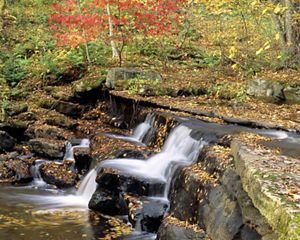
Clinch Valley Program
Conserving the Clinch River, and supporting nature-based economic and recreational opportunities in Southwest Virginia communities.
lastUpdated lastUpdated
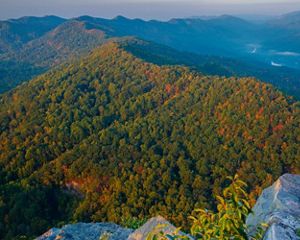
The Cumberland Forest Project: Conservation at Scale
With many years in the making, this innovative project demonstrates the climate benefits of sustainable forest management while providing positive conservation, community and financial returns.
lastUpdated lastUpdated
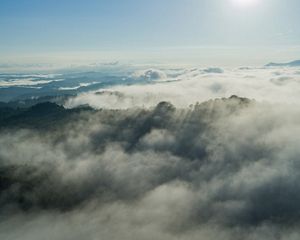
Cumberland Forest Community Fund
Supporting nature-based economic and community development in the Appalachian regions of Southwest Virginia, Tennessee and Kentucky.
lastUpdated lastUpdated
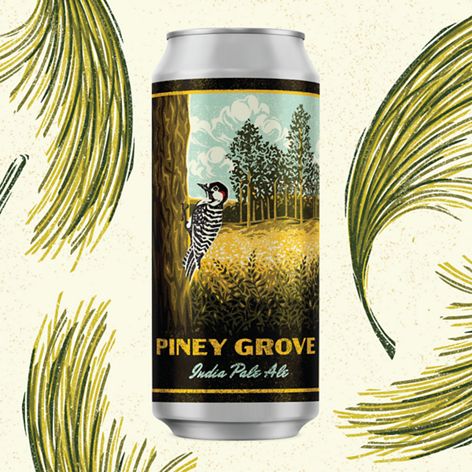
Piney Grove IPA
Longleaf pine needles gathered from Piney Grove Preserve—the northern front for initiatives to restore the South's signature longleaf pine forest—enhance the hoppy nuances of this India pale ale.
A Crazy Idea
Josh Chapman, owner of Upweller Beer Company, was reading his morning newspaper in July of 2019 when a wild idea popped into his head. After reading about efforts to restore Virginia’s longleaf pine ecosystem, Chapman reached out to The Nature Conservancy with a proposition.
“Hey, I know this is gonna sound crazy,” Chapman recalls saying to open the conversation. “I really want to make a beer using this crazy longleaf pine. Do you think that's possible? Can we spare some needles?”
Chapman and his crazy idea found a receptive audience in Bobby Clontz, who manages TNC’s Piney Grove Preserve in Sussex County—epicenter of the Virginia Pinelands.
“One thing led to another, and I'm on a Gator with Bobby Clontz, and my little babies and Jen are with me,” Chapman says. “We're barreling through the Piney Grove Preserve and looking at [red-cockaded] woodpeckers, and it was a magical experience.”
From Piney Grove to Piney Notes
Following the whole Chapman family’s tour via all-terrain vehicle of Piney Grove, home to the rare red-cockaded woodpecker, the group not only gathered green pine needles but also collected branches, bark and cones from the ground.
With his chef’s experience and sensibilities, Chapman is especially fond of fresh, local ingredients. But pine needles? Cones? Bark? Sticks? Isn’t that taking the locavore notion a bit far?
From Forest to Glass
From a “crazy” idea to make a craft beer with longleaf pine to an effort to raise awareness of the urgent need to restore Virginia’s founding forest.
Explore Virginia's Pinelands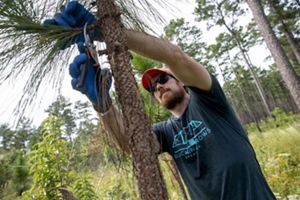
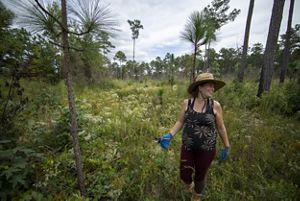
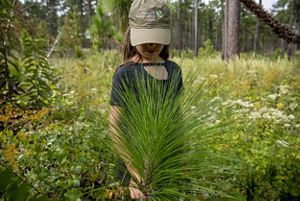
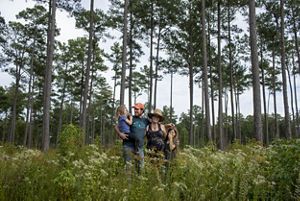
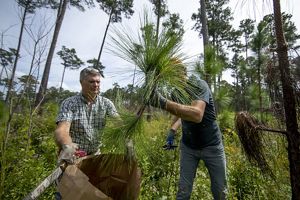
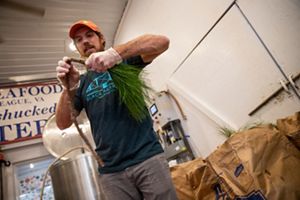
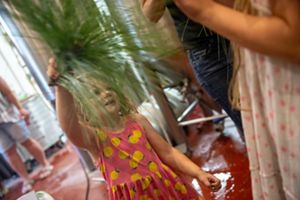
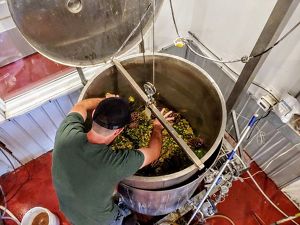
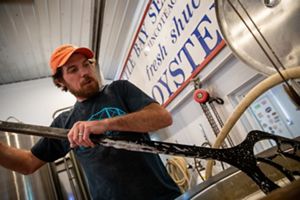
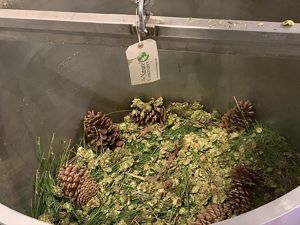

Gathering Ingredients: Brewer Josh Chapman collects branches from a longleaf pine at TNC's Piney Grove Preserve. Hops—a key beer ingredient—are known for imbuing “piney” notes into the flavor. © Kyle LaFerriere Photography

Exploring a Pine Savanna: Black Narrows Brewing co-founder Jenna Chapman walks through TNC's Piney Grove Preserve on the hunt for ingredients that will form the basis for an India Pale Ale style beer. © Kyle LaFerriere Photography

Small Beginnings: Emma Chapman stands next to a longleaf pine tree in the bottlebrush stage. Longleaf uses much of its early growing energy to put down a massive root system. © Kyle LaFerriere Photography

A Family Business: Josh and Jenna Chapman, founders of Black Narrows Brewing, with their daughters at TNC's Piney Grove Preserve. © Kyle LaFerriere Photography

Harvesting Ingredients: “I was blown away by the passion of the team behind the longleaf restoration. I immediately felt a camaraderie." Josh Chapman with Piney Grove Preserve Manager Bobby Clontz. © Kyle LaFerriere Photography

Prepping Ingredients: Back in Chincoteague at Black Narrows Brewing, Josh Chapman breaks down longleaf pine branches into smaller parts to fit into the brewing tanks. © Kyle LaFerriere Photography

Key Ingredients: The littlest Chapman holds up a longleaf pine branch laden down with needles, ready to be added to the mix and provide essential flavor notes and aroma. © Kyle LaFerriere Photography

A Toast to Longleaf: Craft brewer Josh Chapman tends to the longleaf pine needles, branches and cones that form the base for Black Narrows Brewing's Piney Grove IPA. © Black Narrows Brewing

The Brewing Begins: "I was a chef before I was a brewer, so I approach all our beers with a desire to express time and place." Josh Chapman, co-founder, Black Narrows Brewing. © Kyle LaFerriere Photography

Whirlpool Steep: "I went into the brew with the intention of treating the pine like it was the hop addition, and I wanted to get as much aroma as possible.” © Josh Chapman / Black Narrows Brewing
If you’re imagining a concoction that tastes like a household cleaner, consider that several varieties of hops—a key beer ingredient—are known for imbuing “piney” notes into the flavor profile.
Chapman enthusiastically dumped his collection of unique natural ingredients into the boil for a new IPA (India Pale Ale). The first version of his pine-inspired concoction, which Chapman dubbed Forest of Forgotten Trees IPA, began flowing from taps that October.
“The cool thing was bringing it all back here, getting to use the ingredients and having the beer turn out even better than I could have hoped,” he says.
Buoyed by the success of that initial brew, Chapman has continued to refine his recipe and return to the Pinelands to replenish his pantry. For him, the “grapefruity notes” from longleaf not only impart a great taste but also evoke a sense of place—in this case, of the Virginia Pinelands and iconic longleaf pine savannas.
“When people come here, they get to taste where they are,” Chapman says. “The more that our beers can reflect where they come from, the better people will be and the better planet we’ll have.”
Quote: Josh Chapman
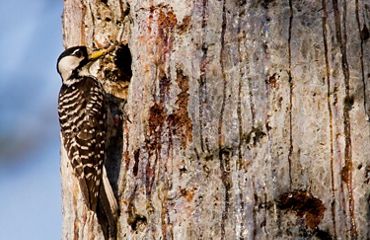
Knowing the amazing work that TNC has done on the Eastern Shore, it just made sense to reach out and see if we could use local beer to highlight longleaf pine.
Explore Our Work
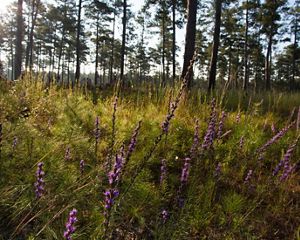
Virginia Pinelands Program
Protecting centuries-old cypress swamps, the state's rarest bird and iconic longleaf savannas.
lastUpdated lastUpdated
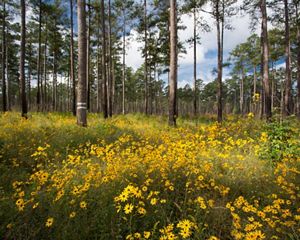
Traveling Through Time in the Virginia Pinelands
A journey through Virginia’s iconic forest habitat.
lastUpdated lastUpdated
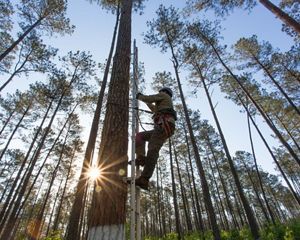
Red Cockaded Woodpecker Recovery
Writing a new page in the recovery story of Virginia's rarest bird.
By Daniel White | lastUpdated lastUpdated
We Can’t Save Nature Without You
Sign up to receive monthly updates from Virginia.
